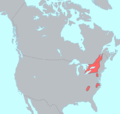A language is head-marking if the grammatical marks showing agreement between different words of a phrase tend to be placed on the heads (or nuclei) of... 7 KB (921 words) - 07:35, 22 March 2024 |
criterion in language typology in which languages are classified according to whether they are more head-marking or dependent-marking. Many languages employ... 3 KB (433 words) - 12:34, 16 February 2022 |
linguistics, head directionality is a proposed parameter that classifies languages according to whether they are head-initial (the head of a phrase precedes... 59 KB (7,432 words) - 00:06, 27 January 2024 |
common to classify language morphology according to whether a phrase is head-marking or dependent-marking. A given dependency is head-marking, if something... 10 KB (1,394 words) - 02:39, 17 November 2023 |
Dependent-marking language Head-marking language Zero-marking language Nichols, J. 1986. Head-marking and dependent-marking grammar. Language 62, 1, 56-119... 2 KB (248 words) - 09:46, 14 October 2020 |
A zero-marking language is one with no grammatical marks on the dependents or the modifiers or the heads or nuclei that show the relationship between... 3 KB (347 words) - 15:35, 2 September 2023 |
 | consonants. The Iroquoian languages are polysynthetic and head-marking. As of 2020, almost all surviving Iroquoian languages are severely or critically... 14 KB (1,193 words) - 08:06, 20 April 2024 |
Marker (linguistics) (section Types of marking) Dependent-marking language Head-marking language Double-marking language Zero-marking language Maddieson, Ian. "Locus of Marking: Whole-Language Typology"... 2 KB (295 words) - 09:39, 29 January 2022 |
 | of the first syllable of root). Chamorro is a predicate-initial head-marking language. It has a rich agreement system in the nominal and in the verbal... 43 KB (3,501 words) - 23:38, 9 May 2024 |
However, many descendants of fusional languages tend to lose their case marking. In most Romance and Germanic languages, including Modern English (with the... 10 KB (1,092 words) - 16:19, 21 April 2024 |
 | Ojibwe language is polysynthetic, exhibiting characteristics of synthesis and a high morpheme-to-word ratio. Ojibwe is a head-marking language in which... 82 KB (8,708 words) - 04:07, 11 May 2024 |
agglutinating, polysynthetic head-marking language, but many of its affixes combine into contractions more like fusional languages. The canonical word order... 20 KB (1,532 words) - 21:03, 19 February 2024 |
chart above, Abui has /r/ and /l/ as separate phonemes. Abui is a head-marking language; pronominal prefixes mark the possessors on nouns and undergoer... 25 KB (3,130 words) - 02:02, 21 January 2024 |
Grammatical case (redirect from Case marking) example of a language in which case marking occurs on all sub-constituents of the NP; see the following example in which the demonstrative, head, and quantifier... 72 KB (6,640 words) - 07:50, 8 April 2024 |
Sango Yoruba Auxiliary verb Free morpheme Isolating language Zero-marking language Synthetic language Linguistic typology See pp. 50–51 in Zuckermann, Ghil'ad... 8 KB (875 words) - 06:58, 7 May 2024 |
Innu-aimun (redirect from Montagnais language) there is no contrasting short e. Innu-aimun is a polysynthetic, head-marking language with relatively free word order. Its three basic parts of speech... 12 KB (993 words) - 05:59, 27 April 2024 |
Khmer language Thai language Central Flores languages Analytic language Free morpheme Linguistic typology Synthetic language Zero-marking language "A Computerized... 6 KB (600 words) - 05:40, 7 May 2024 |
term polysynthetic to languages with high morpheme-to-word ratios, but others use it for languages that are highly head-marking, or those that frequently... 36 KB (4,679 words) - 18:47, 9 November 2023 |
a heavily dependent-marking language, is an exception to the generalization that the obviative occurs in head-marking languages. Obviation is not overtly... 10 KB (1,116 words) - 23:37, 10 October 2023 |
agglutinative language is a type of synthetic language with morphology that primarily uses agglutination. In an agglutinative language, words contain... 9 KB (993 words) - 00:23, 3 April 2024 |
the head (or modified noun) and the dependent (or modifier noun). In dependent-marking languages, a dependent genitive noun modifies the head by expressing... 12 KB (1,713 words) - 10:02, 15 April 2024 |
tendency in the Paumarí language highlights exactly why languages such as Paumarí are endangered. It is a largely head-marking language with unmarked SVO word... 14 KB (1,963 words) - 03:37, 30 January 2023 |
sample of the world's languages (one per stock) and tabulates typological characteristics such as: Head-marking vs. dependent-marking Morphological complexity... 4 KB (526 words) - 14:51, 20 March 2023 |
pronouns have morphological case. Kambera, as a head-marking language, has rich morpho-syntactic marking on its predicators. The pronominal, aspectual and/or... 16 KB (1,858 words) - 10:45, 24 November 2023 |
tense, mood, person, gender, number, and evidential marking. Bulgarian is a fusional inflecting language with some analyticity (including prepositions in... 27 KB (2,931 words) - 23:12, 6 April 2024 |
them from their bilabial counterparts. Big Nambas is a synthetic, head-marking language. Nouns in Big Nambas are capable of phrasal expansion. There are... 6 KB (505 words) - 16:53, 29 December 2023 |
Papuan language spoken in Miyah District, Tambrauw Regency of Southwest Papua, Indonesia. The Meyah language is agglutinative and head-marking and has... 7 KB (614 words) - 02:21, 9 March 2024 |



